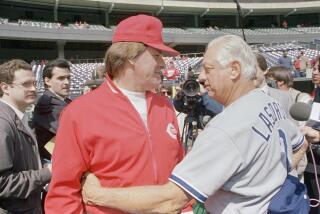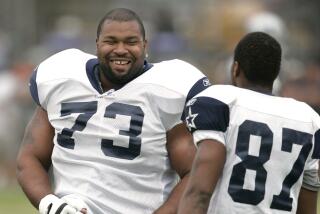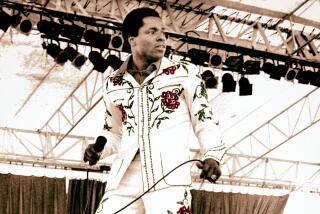Always His Own Man, Allen Lived to Win
They buried George Allen Friday. It was sooner than it should have been. A lifetime innovator, creator of the nickel defense, George, you always presumed, set up coverage to stop even death.
George hadn’t been feeling well for maybe two weeks. He had encountered a breathing problem, not sure whether it was a virus or something more serious.
He telephoned me, asking the number of the cardiologist, Dr. Nicholas Diaco, who tended me at St. John’s Hospital during a time just as well forgotten. I asked George: “Are you having pains in the left arm, chest, or even your right side?”
“I don’t know,” he answered, confused. “You start thinking about these things and you get spooked. You don’t know whether pains are real or imagined.”
He turned up for tests at a Torrance hospital, then returned home. A copy of the report, mailed to Diaco, showed a leaking heart valve.
But George began to feel better. Last Sunday, he went to dinner with his wife, Etty.
“After dinner,” she recalls, “we went home, and George built a fire. He held my hand. He had picked some flowers for me that day and arranged them in a vase. He was so proud of himself. George was such a klutz.”
The next morning, George arose, put on his robe and slippers and turned on the USC-Michigan State game. His wife went for her morning walk. When she returned, she found George on the floor, unconscious. The football game on TV was still going.
Instantly, she tried mouth-to-mouth resuscitation. Then, calling paramedics, she was given instructions over the phone while a crew was dispatched.
George was gone. It was that fast, that simple, that terrifying to the poor woman to whom he was married almost 40 years.
The Allen family is a good-humored troupe, the wife and four children having found humor mostly in the capers of George. When he wasn’t coaching, he dabbled in a multitude of enterprises, almost all of which exploded.
Never had one beheld a bigger patsy for a blue skies story than George. A one-man Laurel and Hardy in matters of business, he cost himself a fortune while he was coaching the Washington Redskins. A contract clause gave him the option, by a certain date, to buy 5% of the Redskins for $500,000.
Trusting George paid no attention to the deadline, believing the opportunity always would be there, considering the job he did at Washington.
But when the deadline passed, ownership pulled the option clause off the table. Today, 5% of the Redskins is worth maybe $7 million.
It was George who conceived the idea of a football training compound outside Washington. He encouraged ownership to buy land near Dulles Airport, establishing Redskin Park for about $600,000. Recalled George before his death: “The land was recently sold for $10 million. My cut: zero. Another brilliant Allen move.”
Obsessed with running, George in his 60s entered 5K and 10K events. At 70, he tried a marathon. He had served as a physical fitness chairman, deeply troubled by the fact children in the Soviet Union, Germany, Israel, Japan and other places could do more push-ups than American kids.
“Why do these push-ups mean so much to you?” I asked him one day.
He answered: “You build your body and you build your mind.”
It’s a debatable philosophy, but George, in the eyes of those who knew him and in those of his family which loved him, was his own kind of nut.
Who else but George would issue an order at the training table cafeteria that the crackers sit immediately adjacent to the soup?
“You put soup at one end of the serving line and crackers at the other,” he explained, unblinkingly, “and you’ve got an organization that isn’t in sync.”
Shifting from Washington to the Rams in 1978, he invited me to lunch at camp. Fastidious about diet, he placed on his tray only soup, crackers and two chocolate chip cookies.
Then, talking football, he absently broke up the chocolate chip cookies into the soup.
George rarely cussed. But looking about the cafeteria, he noticed on the wall a painting of a desert sunset. He rose from his chair.
“What the hell kind of picture is that?” he exclaimed. “Why don’t we have pictures on the wall of Butkus or Waterfield?”
Fanatically tidy, George imposed his habits on those playing for him, always beseeching his troops to comport themselves professionally.
But he never tried to stop demonstrations after scoring plays. A running back used to pray in the end zone after he scored. Asked if this were appropriate, George responded: “Maybe it isn’t. But he prays in a good place.”
Hardly your conventional leader, George was blessed with a special touch for coaching. Innately, he knew what it took to win. He knew how to teach people to do it. And the personal sacrifices he made in pursuit of his job were outrageous to some, but not to George.
The sign in his office, “100% Isn’t Enough,” made visitors laugh, but George lived by such codes, however wacko.
When, at 72, he accepted the coaching post at Cal State Long Beach, his wife joked: “George, I’m afraid, has entered into senility.”
Losing his opener, 59-0, to Clemson, he faced the grim prospect in 1991 of opening against Miami.
“What can I do to avoid it?” he asked.
The answer he found is touching.
More to Read
Go beyond the scoreboard
Get the latest on L.A.'s teams in the daily Sports Report newsletter.
You may occasionally receive promotional content from the Los Angeles Times.










